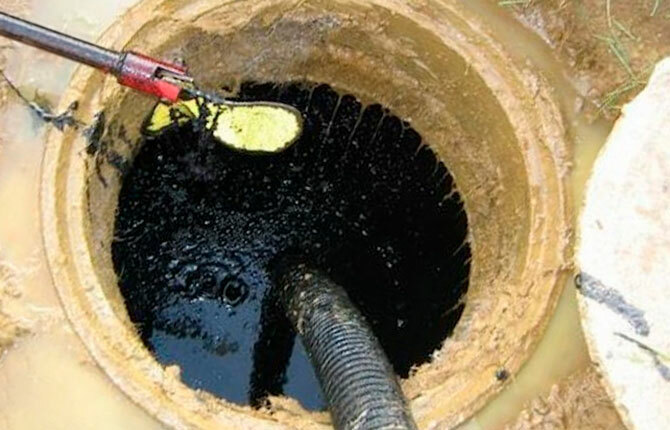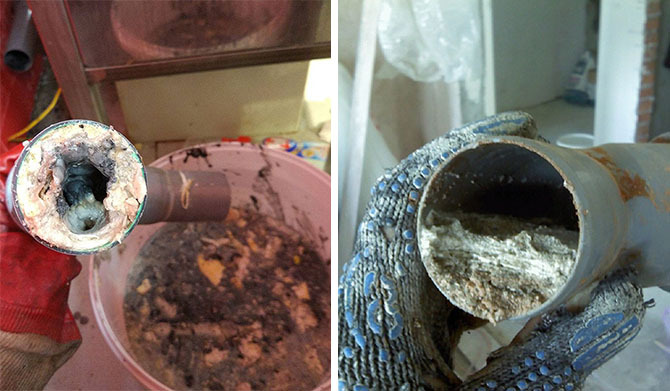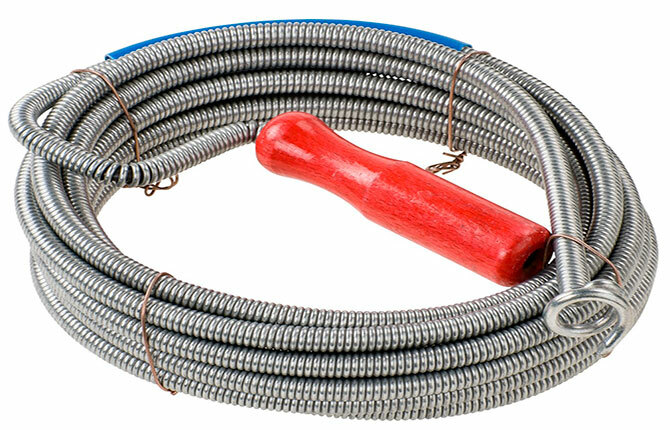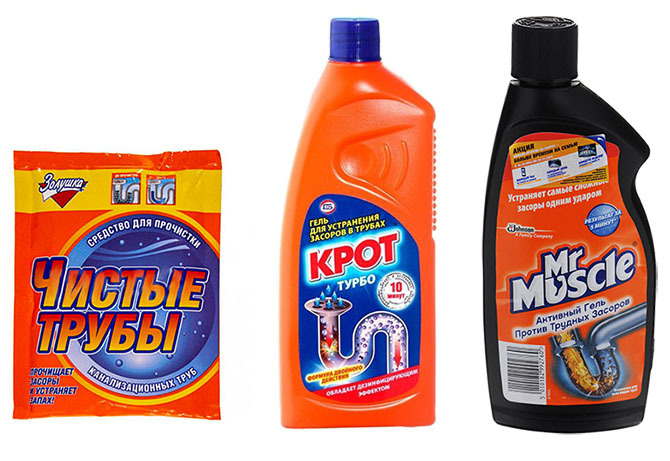A clogged sewer reduces the comfort level of living in a house or apartment. You can clear the sewer blockage both by involving specialists and on your own. The complexity of the work depends on the type of cleaning chosen.
The content of the article:
- Causes of blockages
- How to clean the sewer system in a private house with your own hands
- What leads to blockages
- How to find the area where the blockage occurred
- Mechanical sewage cleaning
- Pipe clogged with paper
- Food waste clogging
- Chemical cleaning of sewerage
- Sewer cleaning with wire
- Sewer flushing
- Sewer blockage remedy
- Blockage prevention
Causes of blockages
Liquid flow blockage can occur for several reasons. To avoid the occurrence of a blockage in the sewage system in the future, it is necessary to identify the cause and eliminate it. Sewerage clogged in the following cases:
- Installation violations. Incorrectly selected angle of inclination, a large number of turns, etc. becomes the cause of sewage blockage.
- The end of the pipe life. Natural wear and tear of the inner surface leads to the accumulation of fatty deposits. Metal structures are negatively affected by corrosion.
- A large amount of fat and soap accumulation. Remains of food and decomposition products of hygiene products settle on the walls of the sewer. The internal space narrows and a sewer blockage forms.
- Ingress of a foreign object. This type of blockage is common when flushing foreign objects down the toilet. These are toilet paper, personal hygiene items, etc.
- External damage to the line. Chips and cracks occur as a result of mechanical stress on the product. Chips prevent the free movement of large waste along the highway.
- High level in cesspool. When filling the well, the free exit of liquid from the line is blocked. At the same time, fat deposits intensively settle on the pipe walls, and a sewer blockage is formed.

- Irregular use of the system. Drying, soapy deposits make the inner surface of the line rough. This contributes to the rapid accumulation of dirt.
Correct installation and use of the sewage system will reduce the risk of contamination of the drainage system.
How to clean the sewer system in a private house with your own hands
It is possible to eliminate blockages in sewer pipes without specialists. To do this, the area where the cork has formed is identified, and cleaning is carried out in one of the following ways:
- Flushing. Suitable for light dirt. The method involves supplying a large amount of hot water to the mains. When passing through the system, the liquid washes away the impurities that are on the walls.
- Use of chemicals. With a slow flow of dirty water, specialized chemicals are poured into the system to destroy soap and fat deposits.
- Mechanical cleaning. The method involves removing the plug with various devices. The method is well suited for removing blockages from sewers, even of a high degree of complexity.
The user independently determines the degree of contamination. The choice of method is carried out separately for each case.
What leads to blockages
In most cases, sewage pollution occurs due to a malfunction during operation. Users do not equip sink drain holes with additional filters (nets). Large particles of food waste get stuck in the sewer.

Lack of preventive measures over time leads to blockage of the pipe. In some cases, users flush toilet paper, cotton pads, and other hygiene items down the toilet. Before removing the sewer blockage, determine at what interval it was formed.
How to find the area where the blockage occurred
The owner can independently determine where the traffic jam has formed. This does not require the use of specialized equipment and tools. You can identify the area by comparing the speed with which dirty water flows down at different drainage points.
If in the sink and sink the liquid flows down at the same time slowly, which means a blockage in the main sewer line. If at one of the points the liquid drains more slowly, the contamination is located in the interval from the point of intake to the line.
The siphon of a sink or sink, in which drainage is difficult, is disconnected from the sewer pipe. After that, its end is lowered into a container and water is turned on. If the drain is difficult, the siphon is dirty. Normal fluid flow indicates that a plug has formed in the sewer pipe between the siphon and the main line.
Mechanical sewage cleaning
The most effective is the mechanical cleaning method. It provides for the promotion of a specialized cable along the channel.

A handle is attached to one side of the product. It is necessary to turn the cable when feeding. To facilitate the procedure, 2 people are involved in the work. The work is performed in the following order:
- Free access to the channel is provided. To do this, disconnect the siphon, dismantle the corrugation of the toilet bowl or open the inspection hole on the pipeline.
- One person feeds the rope through the hole. In this case, the second slowly turns the handle.
- After pushing through the blockage, remove the cable from the pipeline.
- A specialized nozzle in the form of a brush is installed on the cable.
- Repeat the cleaning procedure.
Rotating inside the pipeline, the nozzle cleans its surface from contamination. It should be borne in mind that the cable must be turned in one direction.
Pipe clogged with paper
When flushing toilet paper in toilet bowl a plug may form. You can use a rope to clear the blockage. During operation, toilet paper will be wound around the end of the cable. The cable is removed from the pipeline gradually, avoiding sudden jerks.
After removing the sewer blockage from paper, no additional measures are required. The system will operate normally.
Food waste clogging
If a blockage occurs due to the accumulation of grease and food waste, using only the rope is not enough. This is due to the fact that when twisting, the edge of the cable removes the cork, but does not clean the inner surfaces of fat deposits. This contributes to the rapid formation of a new blockage.
For effective cleaning of the sewer blockage, the cable and the flushing of the pipeline with hot water alternate. When heated, the fat layer becomes softer, which allows it to be maximally cleaned from the walls. Mechanical cleaning and flushing is repeated until the rate of drainage is normalized.
Chemical cleaning of sewerage
The method is used for low degree of contamination. The procedure provides for filing in pipeline specialized chemicals.
Under their influence, fats of vegetable and animal origin dissolve. Different compositions allow you to choose a chemical agent for removing fat, soap deposits, hair, food residues, etc.

Chemicals are not able to remove deaf and foreign blockages. When the inner space of the pipe is completely closed, the chemical agent acts on a small part of the pollution. The exposure area should be as large as possible. If necessary, combine mechanical and chemical methods.
Sewer cleaning with wire
Short pipeline sections are cleaned with wire. For this, steel wire is used. The technology for carrying out work is identical to cleaning with a cable. To get out the blockage, a hook is made at the end of the wire.
When feeding, the wire is scrolled in one direction. The use of wire with a long line length is impossible. Violation of this rule can lead to bending and jamming of the product inside the pipe.
Sewer flushing
When the first signs of a sewer blockage appear, you can clean the inner surface of the pipeline using flushing. For this, a large amount of hot water is supplied to the drainage point.
To improve the result, in some cases citric acid, soda, vinegar and other folk remedies are added. Washing is carried out several times until the rate of drainage is completely normalized.
Sewer blockage remedy
There is a selection of sewer blockage chemicals on the market. The scope of its application depends on the composition of the substance. All funds can be divided into 2 groups:
- To remove fat. Alkaline-based substances work well. They break down vegetable and animal fats.
- For removing soapy deposits. Products containing acid destroy soapy deposits on the surface, hair, etc.
When choosing a tool, take into account the material from which the sewage system is made. Some substances can contribute to the rapid destruction of the pipeline.
Personal protective equipment must be used when supplying chemicals to the pipeline. This will exclude the possibility of getting the substance on open areas of the body or in the eyes.
Blockage prevention
To avoid the formation of a blockage in the sewer, several rules must be followed. Carrying out preventive measures will allow the system to work in normal mode for a long time. Sewer maintenance rules:
- Eliminate the ingress of foreign objects into the line. Do not flush toilet paper, cotton pads, or other hygiene items down the toilet.
- Install additional screens at the point of fluid intake. They will prevent large particles from entering the pipe.

- Monitor the liquid level in the sump. This will eliminate stagnation of dirty water in the system.
- Avoid mechanical stress on the line leading to fractures, chips and cracks.
- Check the drainage rate periodically.
The owner of a house or apartment is able to identify the formation of a blockage in the sewer and remove it with his own hands. Given the reason why free drainage, you can choose a cleaning method. If necessary, you can combine different methods of elimination. This allows you to maximize the effect of the procedure.
Have you done the cleaning of the line blockage yourself? Which method was used in your case?
In the video you can see how to clean the sewer with a plumbing cable:


